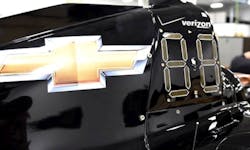IndyCar racing autos will sport LED-based display panels for fan information
LED display panels on each race car, implementing a two digit seven-segment display, will provide data such as position in field, pit stop time, and use of Push to Pass function during the running of IndyCar races.
The IndyCar open-wheel racing body has announced that each car will carry two new LED-based displays during all future races. The panels mounted on each side of the air intake behind the drivers' head will be capable of displaying two digits in multiple colors. The displays are meant to serve fans, at the track and watching on TV, immediate and real-time data such as a driver's position in the race field.
High-brightness LEDs have been utilized in many ways surrounding auto racing. For example, large-format LED-based displays are a mainstay at racing events with even race sponsors hosting dedicated displays. And LED lights make the cars at the Iconic Petty Garage sparkle. Moreover, the IndyCars sport a variety of LED indicators in the cockpit. But the use of panels on the sides of the car, that are large and bright enough for fans to read as cars race by, is truly a novel concept.
Interested in more articles & announcements on LED displays?
The move to develop the LED displays was driven purely in the interest of the fans. "IndyCar is committed to implementing new technology into the Verizon IndyCar Series and this project was about how we can enhance the at-track experience for fans at our events and allow them to understand more of what’s going on," said Derrick Walker, IndyCar president of competition and operations. "If you’re not in the line of sight of a video screen or a scoring pylon, it’s sometimes hard to know who’s doing what on the racetrack. It was a natural to do the numbering system and we’re confident this will help get our fans more engaged at the track."
The panels are 8 in. wide and 7 in. tall and a mere 3-mm thick. Each panel can display two digits, essentially using seven-segment-display technology. Driving such an LED array isn't a terribly difficult task in terms of the electronics required, but the fact that the displays are so easily visible is a testament to the advancements made in high-brightness LEDs.
The primary usage of the panels will be display of the driver's current running position; for example, the leader would have the number 1 displayed. IndyCar already had electronic scoring loops installed at regular intervals around its race tracks to enable precise electronic scoring of results. Now the on-board LED displays will update each time a car crosses a scoring loop.
The displays will be red when showing the driver's race position. IndyCar also allows its drivers to temporarily boost the horsepower of the engine a prescribed number of times with the allocation set specifically for each race course. The feature is called Push to Pass. When a driver uses the Push to Pass feature, the LED display will change to green and display "PP" during the short duration of the acceleration.
The displays will also use green numerals as drivers leave the pit area. The green digits will display the time the driver spent stopped in its pit area such as 7.9 seconds.
The racing organization has been testing the LED display system since the Spring. It will first be used in the race at the Mid-Ohio course on August 2. The testing period was required to make sure the display system was designed properly in terms of brightness. An IndyCar official said the LEDs are so bright that the system had to be tuned to dim the displays to an appropriate level especially in a setting where there is not full sun. Moreover, the displays must be dimmed to 25% of maximum while the car is being serviced in the pits because members of the pit team will be exposed directly to the display at close range.

Maury Wright | Editor in Chief
Maury Wright is an electronics engineer turned technology journalist, who has focused specifically on the LED & Lighting industry for the past decade. Wright first wrote for LEDs Magazine as a contractor in 2010, and took over as Editor-in-Chief in 2012. He has broad experience in technology areas ranging from microprocessors to digital media to wireless networks that he gained over 30 years in the trade press. Wright has experience running global editorial operations, such as during his tenure as worldwide editorial director of EDN Magazine, and has been instrumental in launching publication websites going back to the earliest days of the Internet. Wright has won numerous industry awards, including multiple ASBPE national awards for B2B journalism excellence, and has received finalist recognition for LEDs Magazine in the FOLIO Eddie Awards. He received a BS in electrical engineering from Auburn University.





